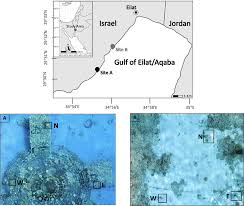Gulf of Eilat: Study

A new study reveals that coral reefs in the Gulf of Eilat experienced a surprising 3,000-year ‘shutdown’ in growth, from about 4,400 to 1,000 years ago, likely due to a temporary drop in sea level that could have been caused by global cooling.
- Gulf of Eilat is also known as Gulf of Aqaba which is the northeastern extension of the Red Sea.
- The northern portion of the Red Sea is divided by the Sinai Peninsula into the Gulf of Aqaba in the east and the Gulf of Suez in the west.
- It is located along the southeastern edge of the Sinai Peninsula and to the west of the Arabian Peninsula.
- It forms an integral part of the East African Rift System and was created by seismic activity along the Afro-Syrian Rift.
- The Tiran Strait connects the Gulf of Aqaba with the Red Sea. It also serves as a connecting point between the continents of Asia and Africa.
- It supports unique and diverse aquatic ecosystems and serves as a vital habitat for some of the world’s richest coral reefs.
- It is bordered by the countries of Israel, Jordan, Egypt and Saudi Arabia.
- Some of the major cities that are situated on the northern end of the Gulf of Aqaba include Taba (Egypt), Eilat (Israel), and Aqaba (Jordan).




